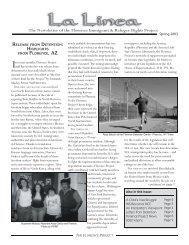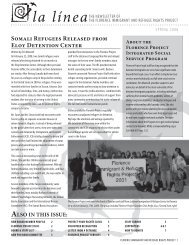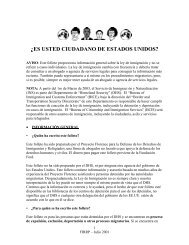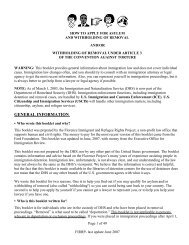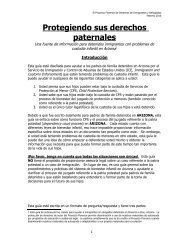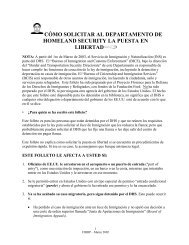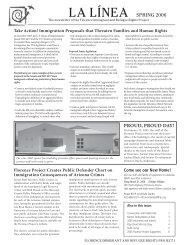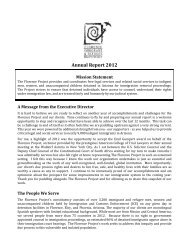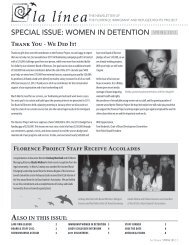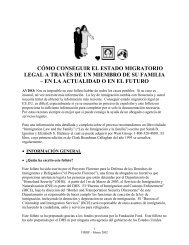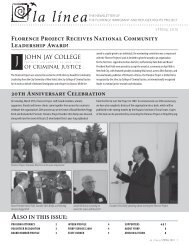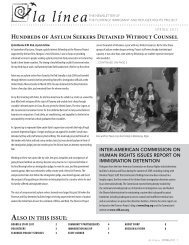quick reference chart and annotations for determining immigration ...
quick reference chart and annotations for determining immigration ...
quick reference chart and annotations for determining immigration ...
You also want an ePaper? Increase the reach of your titles
YUMPU automatically turns print PDFs into web optimized ePapers that Google loves.
Immigrant Legal Resource Center, Florence Immigrant <strong>and</strong> Refugee Rights Project,<br />
Maricopa County Public Defender August 2012<br />
69. Criminal Nuisance, ARS § 13-2908<br />
A. A person commits criminal nuisance:<br />
1. If, by conduct either unlawful in itself or unreasonable under the circumstances, such person recklessly<br />
creates or maintains a condition which endangers the safety or health of others.<br />
2. By knowingly conducting or maintaining any premises, place or resort where persons gather <strong>for</strong><br />
purposes of engaging in unlawful conduct.<br />
B. Criminal nuisance is a class 3 misdemeanor.<br />
Summary: This is a useful plea if the government is willing to plead to a class 3 misdemeanor,<br />
because it has few consequences <strong>and</strong> the facts can fit a variety of situations such as having people use<br />
controlled substances, engage in sex with a minor, etc.<br />
Aggravated felony. No.<br />
Crime involving moral turpitude. No, except possibly if the record of conviction or other<br />
evidence reveals that the unlawful conduct involves moral turpitude. See Matter of Silva-Trevino, 24 I&N<br />
Dec. 687 (A.G. 2008). Even then, recklessness should not involve moral turpitude in this case.<br />
Other grounds. No, The best resolution is to leave the record of conviction vague. However,<br />
even if the record revealed details of the unlawful activity that went on (possessing an unregistered<br />
weapon, using drugs, sexual encounters, etc.), this should not trans<strong>for</strong>m the offense into a firearms, drug,<br />
etc. offense.<br />
70. Use of telephone to annoy; ARS § 13-2916<br />
A. It is unlawful <strong>for</strong> any person, with intent to terrify, intimidate, threaten, harass, annoy or offend, to use<br />
a telephone <strong>and</strong> use any obscene, lewd or profane language or suggest any lewd or lascivious act, or<br />
threaten to inflict physical harm to the person or property of any person. It is also unlawful to otherwise<br />
disturb by repeated anonymous telephone calls the peace, quiet or right of privacy of any person at the<br />
place where the telephone call or calls were received. Class 1 misdemeanor.<br />
Summary: This is an excellent substitute <strong>for</strong> harassment, stalking, or violation of a protection<br />
order charge, if prosecutor is willing, to avoid deportability under the DV grounds. With a vague record<br />
of conviction it may have few <strong>immigration</strong> consequences. It might also be a substitute charge in a<br />
sympathetic statutory rape case.<br />
Aggravated felony: Not as a crime of violence, since the offense carries a maximum sentence of<br />
six months.<br />
Crime involving moral turpitude: Possibly, if the offense involved threats. Defense counsel<br />
should try to plead to an intent to annoy or offend <strong>and</strong> avoid any mention of threats to inflict physical<br />
harm.<br />
Other grounds: If the record shows that the victim had a domestic relationship with the<br />
defendant (either by § 13-3601 or other evidence in the record) <strong>and</strong> the offense involved threats with an<br />
intent to terrify, intimidate, or threaten, this may be deportable as a domestic violence offense or a<br />
stalking offense under 8 USC §1227(a)(2)(E)(i). However, it is still a better alternative than §13-2923,<br />
Arizona Criminal Chart with Explanatory Endnote – August 2012<br />
79



